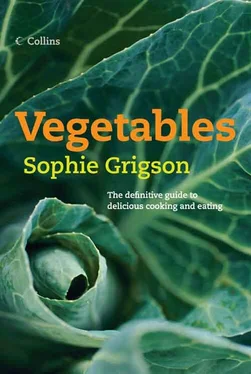Fill the cavity of the chicken with the stuffing. You’ll probably have more than you need, so pack the remainder into a shallow ovenproof dish and bake alongside the bird until browned and hot – it won’t taste as good as the stuffing inside the bird, but it gets the crisp crust as a bonus.
Place the stuffed bird in a roasting tin or shallow ovenproof dish and smear a little olive oil over its skin. Season generously with salt and pepper. Pour a small glass of water around the bird and surround with the celeriac chips. Roast for about 1 1/ 4hours, basting the bird occasionally with its own juices (add a little more water if it needs it) and turning the celeriac chips occasionally – they should soften and catch a little brown here and there.
Test to make sure that the chicken is cooked by plunging a skewer into the thickest part of the thigh – if the juices run clear then it is done. If they run pink and bloody, then get the whole lot back into the oven for another 15 minutes and then try again.
Let the chicken rest in a warm place for 20 minutes before serving.
Whenever we’re in France we head straight for the charcuterie to buy garlic sausage and a tub of céleri rémoulade. In this instance ‘céleri’ is short for ‘céleri-rave’, in other words, celeriac. ‘Rémoulade’ indicates that it is tossed in a mustardy mayonnaise, to transform it into one of France’s favourite salad dishes. Few French domestic cooks ever make their own – why bother when the shop-bought céleri rémoulade is so good? Outside France it is another matter – especially if you make your own mayonnaise, which takes no time at all in a processor or liquidiser. The celeriac itself is best cut by hand, rather than grated, which inevitably produces an over-fine mushy salad. Soften it to agreeable floppiness by soaking in lemon juice and salt for a while.
Either serve your céleri rémoulade as one amongst a bevy of salads, or make it a first course, perhaps accompanied by some lightly cooked large prawns, or thin slices of salty Parma ham.
Serves 6
1 small celeriac
juice of 1 lemon
2 tablespoons single cream
3 tablespoons home-made mayonnaise
2 teaspoons Dijon mustard
salt and cayenne pepper
Peel the celeriac, removing all those knobbly twisty bits at the base. Now cut the celeriac in half, then cut each half into thin slices – you’re aiming roughly at about 3–5mm ( 1/ 8– 1/ 4in) thick, no more. Cut each slice into long, thin strips. Toss the celeriac with the lemon juice as you cut, to prevent browning, then once all done, season with salt and cover with clingfilm. Set aside for half an hour or so to soften.
Drain off any liquid, then toss the celeriac strips with the cream, mayo, mustard, salt and cayenne. Taste and adjust seasoning, then serve.
I’ve given up on making mayonnaise the proper, old-fashioned way. Nowadays, I opt for the quick liquidiser method, which yields up a mayonnaise that is every bit as good and so much less stressful.
Two brief notes. Avoid the temptation to increase the amount of olive oil. In quantity it gives an unpleasant bitterness. The second is the old familiar: as home-made mayonnaise inevitably contains raw egg, do not offer it to the very young, the old, pregnant women, invalids.
Makes roughly 250ml (9floz)
1 egg
1 tablespoon very hot (but not boiling) water
1 tablespoon lemon juice
250ml (9floz) sunflower or grapeseed oil
50 ml (2floz) extra virgin olive oil
salt
Break the egg into the goblet of the liquidiser and add the hot water. Whirr the blades to blend, then add the lemon juice and salt. Measure the oils into a jug together. With the motor running, pour the oil into the egg, in a constant stream, until it is all incorporated. By this time, the mayonnaise will be divinely thick and glossy. Taste and adjust the seasoning.
Roast celeriac with Marsala
This is a repeat recipe, originally printed in my book Taste of the Times , which is now out of print. It is so good, however, that I have no qualms about including it again here. As the celeriac roasts, it absorbs some of the raisiny flavour of the Marsala (but not the alcohol, which just burns off), whilst caramelising to a golden, sticky brownness. Excellent with game, in particular.
Serves 4
1 medium-large celeriac
a little sunflower oil
a knob of butter
5 tablespoons sweet Marsala
salt and pepper
Preheat the oven to 180°C/350°F/Gas 4. Cut the celeriac into 8 wedges, then trim off the skin as neatly and economically as you can. Toss the wedges in just enough oil to coat. Smear the butter thickly around an ovenproof dish, just large enough to take the celeriac wedges lying down flat (well, flattish, anyway). Lay the celeriac in the dish, season with salt and pepper and pour over the Marsala.
Roast for about 1 hour, turning the wedges and basting every now and then, until richly browned all over and very tender. You may find that you have to add a tablespoon or two of water towards the end to prevent burning.
The rarity of chervil root is a small tragedy. I have come across them a mere three or four times in my adult life and I regret profoundly that they are not more common, for they are nothing short of delicious. I first discovered them in a market near Orléans in France. This is their home region. However, even in France they remain bemusingly rare. This may partly be due to their appearance. They don’t look at all promising. Small, brown, dirty cones, looking for all the world like a pile of rough-hewn, old-fashioned children’s spinning tops, they don’t exactly shout ‘buy me’. It may well be that you or I have strode past them without even noticing their presence. Oh that it weren’t so. These insignificant morsels are blessed with a remarkable flavour, something like a cross between a chestnut and a parsnip, and if only you could lay your hands on them, I have no doubt that they would soon become all the rage.
There’s no point angsting about freshness – just grab hold of them if you are lucky enough to find any. Ideally, they should be pleasingly firm, but personally I’d snap them up even if they were just a mite softer and wrinklier – the taste is still good, though they are harder to peel in this state.
Give them a good scrub to remove any dirt (however much elbow grease you employ, the skin will remain unappealingly grubby-looking). The skin is edible, but not especially so. Peel the little darlings before cooking for the best results. They taste fab just simmered in salted wateruntil tender (like a parsnip, this is not a vegetable that benefits from the al dente school of cooking), drained well and then finished with a knob of butter. Even more devastatingly divine, however, are roastchervil roots. Again peel before cooking, then roast in a little olive oil or oil and butter in the normal fashion, until tender as butter inside, lightly browned and a little chewy outside.
Cooked this way, they go spectacularly well with roast beef, or a good steak. I dare say that chervil root has enormous potential and could be mashed, chipped, souped and so on. One day, maybe, I’ll get to find out, but that will just have to wait until the day I can source them regularly, and easily. Roll on that day.
Читать дальше












